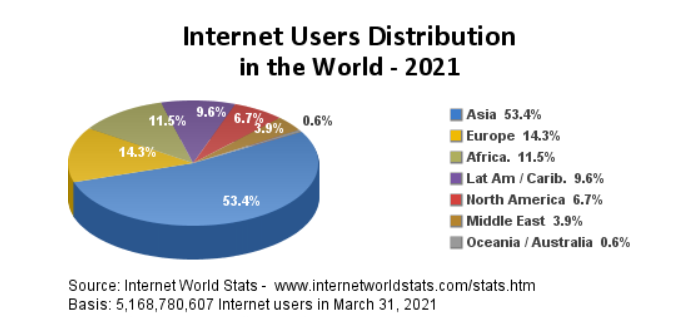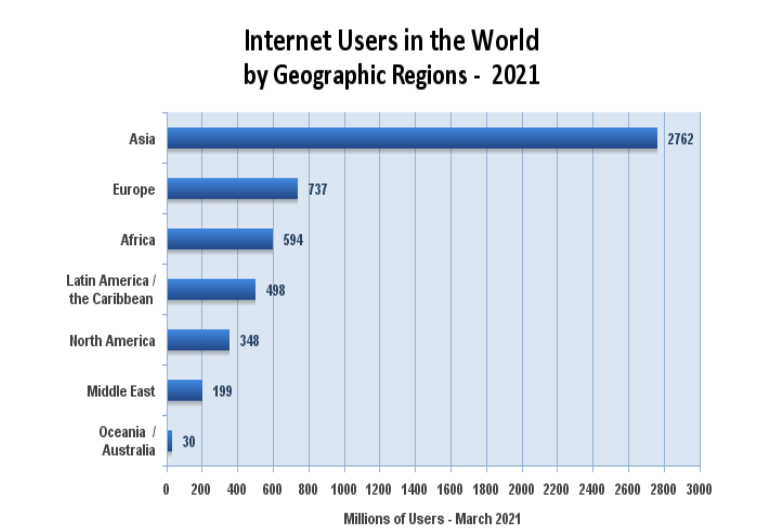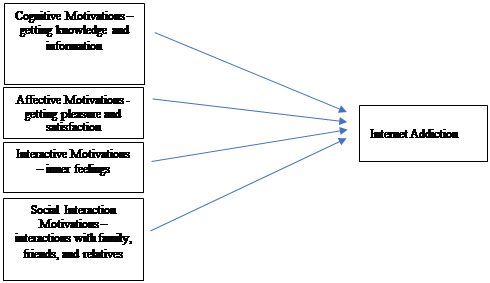Abstract
People have grown increasingly attracted to, and even obsessed with, the Internet as technology has evolved and a myriad of applications have appeared. Neurological difficulties, psychological illnesses, social issues, decreased academic success, sleep disruption, excessive daytime sleepiness, and environmental stresses have all been related to excessive Internet use. Due to the widespread use and increase of internet access, researchers have focused on the uses and social implications of the Online, including internet addiction among Malaysians. The current study consists of a peer-reviewed research article on internet addiction that uses the Uses and Gratifications Theory (UGT) to describe the phenomenon. This theory is focused with establishing why individuals use certain sorts of media, what needs they have for them, and how much pleasure they get from utilising them. Therefore, this study aims to identify the predictors of internet addiction and what makes this internet usage so appealing. This study contributes to the body of knowledge on the phenomenon of internet addiction by presenting relevant findings on the determinants of internet addiction in Malaysia, which are not previously available. This research will also serve as a guideline for parents, educators, and other interested parties in dealing with the issues and planning for the intervention program, which will focus on young adults.
Keywords: Excessive internet usage, internet, internet addiction, Use and Gratification Theory (UGT)
Introduction
Communication, education, employment, business, and commerce all see an uptick due to the widespread adoption of the Internet. By linking all of the computers on the Internet, we can create a worldwide data communications network that offers a wide range of advantages, including faster communication, more information resources, more entertainment, social networking, and general convenience and efficiency in daily life. As of March 31st 2021, there are approximately 5.17 billion Internet users worldwide.

During the period from 2000 to 2021, the number of internet users increased by 1331.9 per cent. Asia, with a population of over 4 billion people, is the most populous continent, followed by Europe and North America (Internet World Stats, 2021).

Refer to Figure 2, people have become increasingly attracted to, and even obsessed with, the Internet as technology has advanced, and a plethora of applications have emerged. Previous research pointed out that game addiction, neglecting daily chores, bad relationship with professors is significantly associated with internet addiction (Baturay & Toker, 2019). Several negative consequences of excessive Internet use have been discovered in previous studies, such as neurological complications, psychological disturbances, and social problems (Cash et al., 2012), lower academic achievement (Anwar, 2014; Kim, 2011; Yildiz Durak, 2019), impairment of sleep, excessive daytime sleepiness and presence of environmental stressors (Vidya et al., 2014).
Globally, several negative consequences of excessive Internet use have been discovered in previous studies, such as neurological complications, psychological disturbances, and social problems (Cash et al., 2012), lower academic achievement (Anwar, 2014; Kim, 2011) impairment of sleep, excessive daytime sleepiness and presence of environmental stressors (Vidya et al., 2014).
While in a Malaysian context, similar trends are observed. There are about 88.7% internet users in the year 2020 with about a 1.3% increase from 87.4% in 2018. 28.6% of Malaysian internet users spent about 5-8 hours use of internet daily and another 24.9% of users spent about 1-4 hours on the internet daily. With regards to the location of internet access, 70.5% of users get access to the internet from their home and 30.1% from their workplace. In addition, 98.7% of Malaysian get access to the internet through their smartphone which implies the reliance on the internet is everywhere and at any time. The purpose of internet access is text communication (98.1%), social media use (93.3%), and use for watching video on the internet (87.3%). In 2020, the top three communication applications are WhatsApp (98.7%), Facebook Messenger (53.9%), and Telegram (49.1%).
While top three social networking applications used are Facebook (91.7%), YouTube (80.6%), and Instagram (63.1%). In terms of online security and privacy, 47.0% of internet users feel secured when using the internet. About 47.0% of children aged 5 to 17 have access to the internet in their daily life which showed an increment of 18.5% since 2018 with only 28.5%. However, only 53.3% of parents are aware of parental control over the internet. Besides, users within 20-24 years old are the highest age group in using the internet (34.1%). As expected, the majority of internet users are from an urban area with 75.6% as compared to users from a rural area with only 24.4% (MCMC, 2021).
The good and the bad of the internet has been a continuous debate – it’s penetration rate in youths is of particular concern. Malaysia recorded a notable increase in national internet usage from 76.9% to 88.7%, in a 4-year period, with 85.9% of them being individuals aged 44 and below (MCMC, 2021). Although Malaysia has good nationwide internet connectivity, and Malaysian in general enjoy equal opportunity for internet access, overdependence on the internet is a grave that has enveloped Malaysian young adolescents which could lead to a variety’s consequences.
The extensive use and growth of internet access, has drawn the attention of researchers, leading to this area of study which focuses on the uses and social impacts of internet used specifically internet addiction among Malaysians. This study is grounded by U&G theory in explaining the phenomena of internet addiction and what makes this internet usage to be so appealing and what are the factors leading to internet addiction. Therefore, this paper aims to identify the predictors of internet addiction and its impact towards internet addiction among young adults in Malaysia.
Problem Statement
The internet is increasingly becoming an integrally being part and partial of our daily lives. It offers a plethora range of activities: games, social- interaction, communication, and information retrieval ranging from academic matters to other social matters. Research has shown that users can gain academic, economics, financial, job-related, and social benefits from using the internet (Jackson & Saunders, 2006). People without access to internet faced serious economic consequences since internet becomes indispensable to many people and corporations and information technology skills become progressively critical in the labour market (Hoffman et al., 2004). However, there is also alarming growing trend of negative incidents attributed to the internet. The most affected social entity is young adolescents due to their innocence, gullibility, and heavy online usage (Kim et al., 2018). The government of Malaysia particularly concerned about the negative impact of the internet among Malaysian (Khan, 2018).
Research Questions
The research questions of this research are:
What are the motivations of internet usage among Malaysian?
What are the impacts of the internet addiction?
Purpose of the Study
Among the priorities highlighted in the recent study are:
To analyse the motivations of internet usage among Malaysian.
To identify the impacts of internet addiction in Malaysia.
Research Methods
Not every internet user is at risk of pathological Internet use. Individuals respond to Internet applications differently based on their own psychological and social traits. Although the criterion to define pathological Internet use or Internet addiction is complex and inconsistent in academic research, some specific performance on this population have been confirmed and supported by most research, such as loss of impulse control to become unmanageable for Internet, spend extremely long time on Internet which influence their normal daily activities, psychological and social negative consequences with excessive use of Internet (Balakrishnan & Griffiths, 2017).
Review of the Literatures
Not every internet user is at risk of pathological Internet use. Individuals respond to Internet applications differently based on their own psychological and social traits. Although the criterion to define pathological Internet use or Internet addiction is complex and inconsistent in academic research, some specific performance on this population have been confirmed and supported by most research, such as loss of impulse control to become unmanageable for Internet, spend extremely long time on Internet which influence their normal daily activities, psychological and social negative consequences with excessive use of Internet (Panova & Carbonell, 2018).
In a study on internet uses and gratifications in an Indian context, Roy (2009) identified six gratification motives through factor analysis which then has been categorized into three motivation factors (content gratification, process gratification and social gratification).
A review the prior Internet U&G work revealed that most studies have been conducted with college students and adults, whereas most of the existing works focuses on a wide range of participation, for example, 16 to 54 or 16 to 75 years old internet users (Lee et al., 2014).
Uses and Gratification (U&G) theoretical framework has been extensively used to understand the role of internet U&Gs in predicting internet addiction in the prior literature and most of the factors in U&G explained the relationship are connecting, exposure, information seeking and entertainment (Karimi et al., 2020).
On the other hand, there have been numerous impacts of internet addiction found from previous research. Among the negative impacts of internet addiction inclusive of interpersonal relations where the relationship of an individual seems depart from the physical surrounding (Morahan-Martin, 2005). Some other problems including psychological factors as an individual is incapable to control their emotions and way of thinking due to longs hours of internet usage which finally may affect the work performance of an individual (Young, 2008).
Dhir et al. (2016) then conducted additional research on the association between internet use and gratifications, this time concentrating on individuals aged 12 to 18. Male adolescents prioritise social impact and social gratifications such as networking and coordinating, whereas female adolescents prioritise content satisfaction such as knowledge seeking and exposure to internet addiction. Internet users who own personal computers have a greater need for social and recreational fulfilment than those who do not. On the other hand, internet users who have a personal home internet connection are more likely to seek out higher-quality information, processes, and social gratifications than those who do not have a personal home internet connection.
Identifying Variables
Cognitive motivations – getting knowledge and information as well as having an understanding of people’s social environments, exploration and curiosity (Wang et al., 2017).
Affective motivations – using different types of media for personal needs like pleasure and/ or motivational motivations such as getting satisfaction from a football match aired on television.
Interactive motivations – inner feeling (self-esteem, personal stability, need for self-respect, self-confidence, integrity, social status, etc).
Social interaction motivations – interaction with family, friends, and relatives.
Findings
Based on the variables analysed, the conceptual design framework for Internet Addiction in Malaysia has been outlined and depicted in Figure 1 is the initial proposed framework in this research. It is developed through literature reviews interlinked with Uses and Gratifications Theory (UGT) overview that provide a comprehensive understanding of what this research is trying to achieve (Jabareen, 2017). This framework signifies the motivations of internet usage in Malaysia. There are four (4) motivations of internet usage had been identified in explaining the correlation of internet addiction and Uses and Gratification Theory (UGT).

Conclusion
Internet addiction among Malaysian has become a vigorous discussion due to its negative behavioural consequences. Internet addiction normally derived from a situation of overdependence of internet usage or online activity obsession. This research aims to identify the motivations of internet usage among Malaysian with underlying Uses and Gratification Theory. The awareness among the public, especially parents and educators seem can help to urgently elevate the risks of internet addiction and strategies to use internet in the moderate way. Nevertheless, the strong family attachment can help to rectify plethora issues related to internet addictions. Despite that, the government also came up with effective methods in tackling this emerging public health polemic.
Acknowledgments
The authors would like to extend their gratitude to University of Technology MARA (UiTM) Melaka for generously providing funding to the researcher through TEJA GRANT (GDT 2021/ 2-6) for the year 2021.
References
Anwar, E. (2014). Internet addiction among secondary school children and its relation with their academic achievements. Indian Journal of Research, 3(12), 72–74. http://worldwidejournals.com/paripex/file.php?val=December_2014_1418653147__24.pdf
Balakrishnan, J., & Griffiths, M. D. (2017). Social media addiction: What is the role of content in YouTube? Journal of Behavioral Addictions, 6(3), 364–377.
Baturay, M. H., & Toker, S. (2019). Internet addiction among college students: Some causes and effects. Education and Information Technologies, 24(5), 2863–2885. https://doi.org/10.1007/s10639-019-09894-3
Cash, H., D. Rae, C., H. Steel, A., & Winkler, A. (2012). Internet Addiction: A Brief Summary of Research and Practice. Current Psychiatry Reviews, 8(4), 292–298. https://doi.org/10.2174/157340012803520513
Dhir, A., Chen, S., & Nieminen, M. (2016). The effects of demographics, technology accessibility, and unwillingness to communicate in predicting internet gratifications and heavy internet use among adolescents. Social Science Computer Review, 34(3), 278-297.
Hoffman, D. L., Novak, T. P., & Venkatesh, A. (2004). Has the Internet become indispensable? Communications of the ACM, 47(7), 37–42.
Jabareen, Y. (2017). Building a Conceptual Framework: Philosophy, Definitions, and Procedure. International Journal of Qualitative Methods, 8(4), 49-62. https://doi.org/10.1177/160940690900800406
Jackson, P. B., & Saunders, T. (2006). Work Stress, Coping Resources, and Mental Health: A Study of America’s Black Elite. In Research in Occupational Stress and Well Being (Vol. 5, pp. 139–169).
Karimi, L., Khodabandelou, R., Ehsani, M., & Ahmad, M. (2020). Applying the Uses and Gratifications Theory to Compare Higher Education Students’ Motivation for Using Social Networking Sites: Experiences from Iran, Malaysia, United Kingdom, and South Africa. Contemporary Educational Technology, 5(1), 53–72.
Khan, Z. (2018, June 17). Tingkat Kesedaran Unsur Negatif Keterbukaan Internet. Berita Harian, June, 2018. http://www.bharian.com.my/
Kim, H.-J., Min, J.-Y., Min, K.-B., Lee, T.-J., & Yoo, S. (2018). Relationship among family environment, self-control, friendship quality, and adolescents’ smartphone addiction in South Korea: Findings from nationwide data. PLoS ONE, 13(2).
Kim, S. (2011). The Effects of Internet Use On Academic Achievement and Behavioral Adjustment Among South Korean Adolescents: Mediating and Moderating Roles of Parental Factors. Child and Family Studies, 14–267. https://surface.syr.edu/cfs_etd/62
Lee, U., Lee, J., Ko, M., Lee, C., Kim, Y., Yang, S., Yatani, K., Gweon, G., Chung, K.-M., & Song, J. (2014). Hooked on smartphones: An exploratory study on smartphone overuse among college students. 32nd Annual ACM Conference on Human Factors in Computing Systems, CHI 2014, 2327–2336.
MCMC. (2021). Internet users survey 2020. Statistic and Data Intelligence Department MCMC. https://www.mcmc.gov.my/skmmgovmy/media/General/pdf/IUS-2020-Infographic.pdf
Morahan-Martin, J. (2005). Internet abuse: addiction? disorder? symptom? alternative explanations? Social Science Computer Review, 23(1), 39-48.
Panova, T., & Carbonell, X. (2018). Is smartphone addiction really an addiction? Journal of Behavioral Addictions, 7(2), 252–259.
Roy, S. K. (2009). Internet uses and gratifications: A survey in the Indian context. Computers in Human Behavior, 25(4), 878-886.
Wang, P., Zhao, M., Wang, X., Xie, X., Wang, Y., & Lei, L. (2017). Peer relationship and adolescent smartphone addiction: The mediating role of self-esteem and the moderating role of the need to belong. Journal of Behavioral Addictions, 6(4), 708–717.
Yildiz Durak, H. (2019). Investigation of nomophobia and smartphone addiction predictors among adolescents in Turkey: Demographic variables and academic performance. Social Science Journal, 56(4), 492–517.
Young, K. S. (2008). Internet sex addiction: Risk factors, stages of development, and treatment. American Behavioral Scientist, 52(1), 21-37.
Copyright information

This work is licensed under a Creative Commons Attribution-NonCommercial-NoDerivatives 4.0 International License.
About this article
Publication Date
31 October 2022
Article Doi
eBook ISBN
978-1-80296-958-0
Publisher
European Publisher
Volume
3
Print ISBN (optional)
-
Edition Number
1st Edition
Pages
1-802
Subjects
Multidisciplinary sciences, sustainable development goals (SDG), urbanisation
Cite this article as:
Ali, S. M., Abdul Rasool, M. S., & Ahmad, S. N. A. (2022). Internet Addiction In Malaysia: An Overview Of Uses And Gratifications Theory (UGT). In H. H. Kamaruddin, T. D. N. M. Kamaruddin, T. D. N. S. Yaacob, M. A. M. Kamal, & K. F. Ne'matullah (Eds.), Reimagining Resilient Sustainability: An Integrated Effort in Research, Practices & Education, vol 3. European Proceedings of Multidisciplinary Sciences (pp. 629-636). European Publisher. https://doi.org/10.15405/epms.2022.10.59

